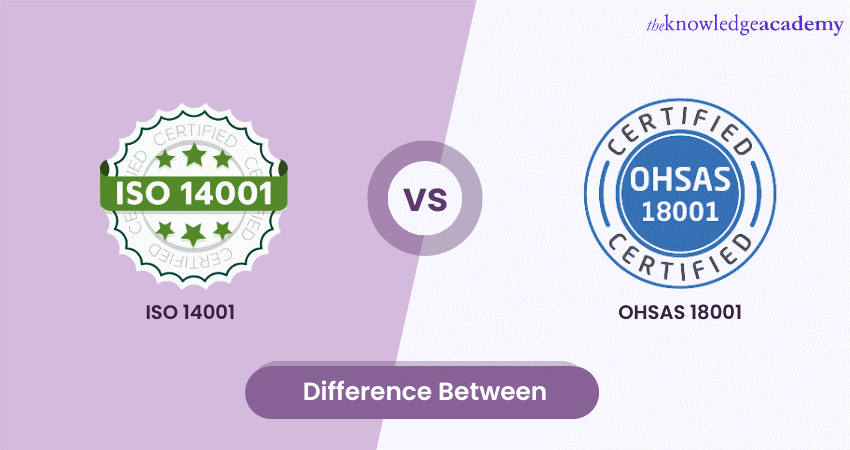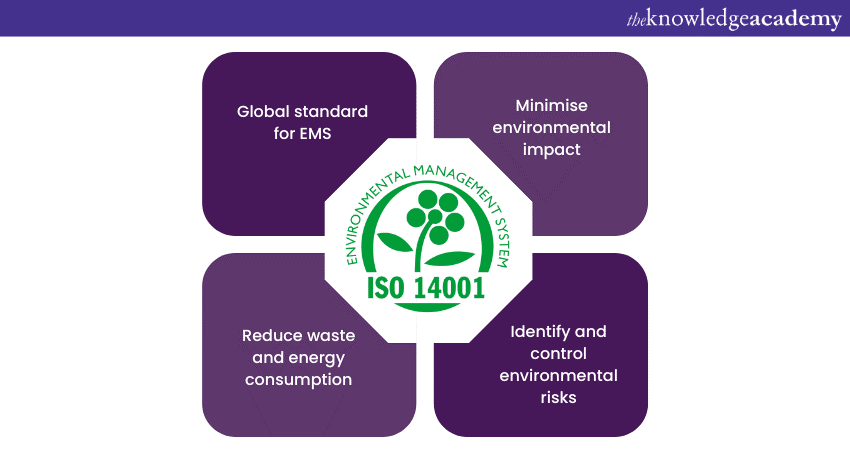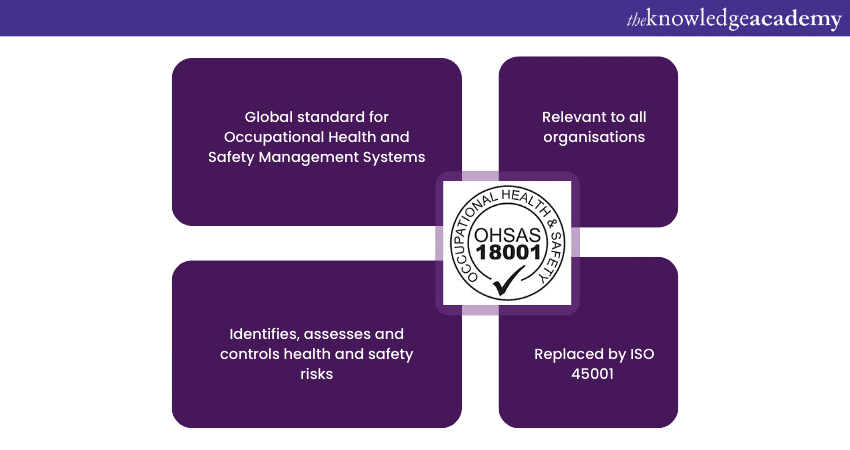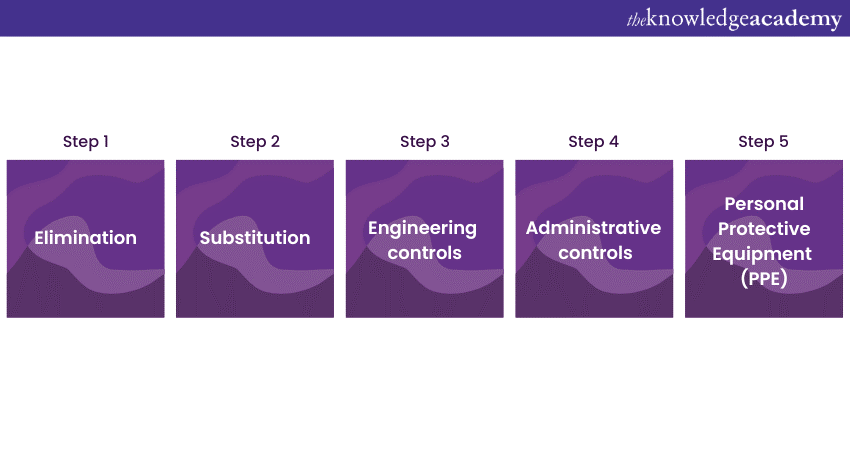We may not have the course you’re looking for. If you enquire or give us a call on +32 35001305 and speak to our training experts, we may still be able to help with your training requirements.
Training Outcomes Within Your Budget!
We ensure quality, budget-alignment, and timely delivery by our expert instructors.

The Difference Between ISO 14001 and OHSAS 18001 standards is a common area of interest for organisations looking to enhance their management systems. ISO 14001 focuses on environmental management, aiming for sustainability and reduced environmental impact.
On the other hand, OHSAS 18001/ISO 45001 is dedicated to occupational health and safety, ensuring the well-being of employees. Understanding the nuances between these two standards is essential for businesses aiming for compliance and improvement in their respective domains. Take a look at the comparisons for each of the standards lSO 14001 vs OHSAS 18001/ISO 45001, in our blog.
Table of Contents
1) Overview of the ISO 14001 standard
2) Overview of the OHSAS 18001 standard
3) A brief look at the steps for risk reduction
4) Looking at the Difference Between ISO 14001 and OHSAS 18001
5) Conclusion
An overview of the ISO 14001 standard
Here is an overview of the ISO 14001 standard, explained below through the following points:

a) Definition: ISO 14001 is the global standard for creating an effective Environmental Management System (EMS).
b) Purpose: It aims to help organisations minimise their environmental impact and comply with relevant laws and regulations.
c) Scope: The standard is applicable across all types of organisations, regardless of size or industry.
d) Framework: Provides a structured approach to setting environmental objectives and targets.
e) Environmental impact: Encourages organisations to reduce waste and energy consumption, promoting sustainability.
f) Compliance: Assists businesses in meeting legal requirements related to environmental performance.
g) Continuous improvement: Emphasises regular monitoring and improvement of environmental performance.
h) Global recognition: Being ISO 14001 certified can enhance an organisation's reputation and provide a competitive edge.
i) Risk management: Helps in identifying and controlling environmental risks and opportunities.
j) Customer confidence: Shows commitment to responsible environmental practices, boosting customer trust.
k) Implementation: It can be implemented alone or integrated with other management standards.
l) Cost savings: Leads to operational efficiency and potential cost savings through waste reduction.
Optimise your organisational processes by signing up for the ISO 14001 Foundation Course now!
An overview of the OHSAS 18001 standard
Here is an overview of the OHSAS 18001 standard, explained below through the following points:

a) Definition: OHSAS 18001 is an internationally applied standard for the Occupational Health and Safety Management Systems (OHSMS).
b) Purpose: It aims to help organisations establish, maintain, and consistently improve their occupational health and safety performance.
c) Scope: The standard is relevant for all organisations, regardless of size or sector, aiming to manage occupational health and safety risks.
d) Framework: Provides guidelines for implementing a systematic approach to managing occupational health and safety, including risk management.
e) Employee safety: Focuses on ensuring a safe and healthy working environment by controlling risks and improving employee safety.
f) Compliance: Assists organisations in meeting legal and regulatory requirements related to occupational health and safety.
g) Continuous improvement: Emphasises regular evaluation and consistent improvement of the occupational health and safety performance.
h) Global recognition: Achieving OHSAS 18001 certification demonstrates an organisation's commitment to the well-being of its employees.
i) Risk management: Helps in identifying, assessing, and controlling occupational health and safety risks.
j) Stakeholder confidence: Enhances credibility and confidence among stakeholders, including employees, customers, and regulators.
k) Integration: Can be aligned with other management standards for an integrated approach.
l) Transition: Please note that OHSAS 18001 has been replaced by ISO 45001 since September 2021, providing an updated framework for occupational health and safety management.

A brief look at the steps for risk reduction
Here are the five key steps in the hierarchy of the risk reduction considerations for the 18001 standard:

a) Elimination: The physical removal of the hazard to ensure it does not pose any danger to the employees. Elimination should be the first line of defence in the hierarchy when possible.
b) Substitution: The most effective method after elimination of the hazard, where a similar non-risky product replaces the hazard.
c) Engineering controls: These controls are designed to isolate employees from the risk, instead of eliminating the hazards completely.
d) Administrative controls: Lights and signs can be utilised as audio or visual warning systems to keep employees distant from a particular risk. The effectiveness of the systems, however, depend on human understanding which is prone to containing errors. Employee training and procedural changes are better alternatives to change the way the team works.
e) Personal Protective Equipment (PPE): PPE comprises of hard hats, gloves, masks, safety goggles, and other equipment which employees may need for their safety on the job. PPE, is however the least efficient option as it depends significantly on fitting, training and maintenance.
Attain the knowledge to implement workplace health and safety, by signing up for the ISO 18001 Foundation now!
Looking at the Difference Between ISO 14001 and OHSAS 18001
Here are the differences highlighted between ISO 14001 and OHSAS 18001, as shown below:
|
Aspect |
ISO 14001 |
OHSAS 18001 |
|
Objective |
Environmental protection, sustainability |
Occupational health and safety management |
|
Scope |
Applies to environmental impacts that the organisation controls or influences |
Covers occupational health and safety risks and hazards |
|
Main focus |
Reduction of environmental impact, compliance with environmental laws |
Ensuring employee safety, compliance with occupational safety laws |
|
Key components |
Environmental aspects, legal compliance, continuous improvement |
Risk assessment, legal compliance, injury prevention |
|
Implementation benefits |
Improved environmental performance, cost savings |
Improved employee safety, reduced workplace incidents |
|
Target audience |
Organisations aiming for environmental sustainability |
Organisations focusing on occupational health and safety |
|
Legal compliance |
Emphasis on environmental laws and regulations |
Emphasis on occupational health and safety laws and regulations |
|
Risk management |
Focus on environmental risk |
Focus on occupational safety risks |
|
Integration with other standards |
Can be integrated with other ISO standards like ISO 9001 |
Often integrated with ISO 14001 and ISO 9001 |
|
Certification impact |
Enhances reputation for environmental responsibility |
Enhances reputation for employee safety commitment |
|
Monitoring and improvement |
Continuous monitoring and improvement of environmental performance |
Continuous monitoring and improvement of health and safety performance |
Conclusion
The Difference Between the ISO 14001 and OHSAS 18001 standards lies in their core focus, namely environmental management, and occupational health and safety. Both standards play vital roles in responsible business operations, each addressing distinct aspects of sustainability and employee well-being.
Implement changes for an eco-friendly organisation by signing up for the ISO 14001 Training now!
Frequently Asked Questions
Upcoming Health & Safety Resources Batches & Dates
Date
 ISO 18001 Foundation
ISO 18001 Foundation
Mon 3rd Feb 2025
Mon 12th May 2025
Mon 1st Sep 2025
Mon 1st Dec 2025







 Top Rated Course
Top Rated Course


 If you wish to make any changes to your course, please
If you wish to make any changes to your course, please


